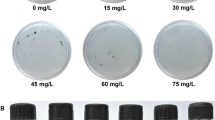Abstract
Candida glycerinogenes WL2002-5 has a modest sugar tolerance and an extremely high glycerol productivity. Agrobacterium tumefaciens can transfer part of its Ti plasmid, the T-DNA, into the nuclear genome of a wide variety of host cells. In this study, we constructed the plasmid pZR and transferred it into A. tumefaciens LBA4404 to form the strain LBA4404-ZR. LBA4404-ZR was cocultivated with C. glycerologenesis, and putative transformants were identified by selection for zeocin resistance. Polymerase chain reaction and Southern blot analysis confirmed that the gene zeocin was integrated into the genome of engineered C. glycerologenesis. Optimization of the transformation condition was performed in darkness at 25°C on induction medium for 24 h by cocultivation of C. glycerinogenes and LBA4404-ZR with a cell ratio of 1:500–1000. The transformation efficiency reached 2 transformants per 104 C. glycerologenesis cells. Our results demonstrated that A. tumefaciens-mediated transformation can be used for C. glycerinogenes. This transformation system can provide the basis for research of C. glycerologenesis in the future.





Similar content being viewed by others
References
Ausubel FM, Brent R, Kingston R et al (1987) Current protocols in molecular biology. Wiley, New York
Bundock P, Den Dulk-Ras A, Beijersbergen A et al (1995) Trans-kingdom T-DNA transfer from Agrobacterium tumefaciens to Saccharomyces cerevisiae. EMBO J. 14:3206–3214
Burke D, Dawson D, Stearns T (2000) Methods in yeast genetics, a Cold Spring Harbor Laboratory course manual. New York: Cold Spring Harbor Laboratory Press, Cold Spring Harbor, NY, pp 103–105
Hinnen A, Hicks JB, Frik GR (1978) Transformation of yeast. Proc Natl Acad Sci USA 75:1929–1933
Ito H, Fukuda Y, Murata K et al (1983) Transformation of intact yeast cells treated with alkali cations. J Bacteriol 153:163–168
Kunik T, Tzfira T, Kapulnik Y et al (2001) Genetic transformation of HeLa cells by Agobacterium. Proc Natl Acad Sci USA 98:1871–1876
Mark M, Gregory J, Pazour AD (1990) Efficient transformation of Agrobacterium tumefaciens by electroporation. Gene 90:149–151
Piers KL, Heath JD, Liang XY et al (1996) Agrobacterium tumefaciens-mediated transformation of yeast. Proc Natl Acad Sci USA 93:1613–1618
Sambrook J, Fritsch EF, Maniatis T (2001) Molecular cloning: A laboratory manual. Cold Spring Harbor Laboratory Press, Cold Spring Harbor, NY
Sugui JA, Chang YC, Kown-Chung KJ (2005) Agrobacterium tumefaciens-mediated transformation of Aspergillus fumigatus: an efficient tool for insertional mutagenesis and targeted gene disruption. Appl Environ Microbiol 71:1798–1802
Thomas BJ, Rothstein R (1989) Elevated recombination rates in transcriptionally active DNA. Cell 56:619–630
Tinland B (1996) The integration of T-DNA in plant genomes. Trends Plant Sci 1:178–184
Weaver JC, Harrison GI, Bliss JG et al (1988) Electroporation: high frequency of occurrence of a transient high-permeability state in erythrocytes and intact yeast. FEBS Lett 229:30–34
Yanish-Perron C, Vieira J, Messing J (1985) Improved M13 phage cloning vectors and host strains: nucleotide sequence of the M13mp8 and pUC19 vectors. Gene 33:103–119
Zhuge J, Fang H-Y, Wang Z-X et al (2001) Glycerol production by a novel osmotolerant yeast C. glycerinogenes. Appl Microbiol Biotechnol 55:686–692
Acknowledgments
The work was supported by the National Natural Science Foundation of China (30570142, 20676053), National Programs for High Technology Research and Development of China (2006AA020103); Jiangsu Provincial Youth Scientific and Technological Innovation Foundation (BK2006504) (Academic Leader), and Program for Changjiang Scholars and Innovative Research Team in University (IRT0532).
Author information
Authors and Affiliations
Corresponding author
Rights and permissions
About this article
Cite this article
Zhiming, R., Zheng, M., Wei, S. et al. Transformation of Industrialized Strain Candida glycerinogenes with Resistant Gene zeocin via Agrobacterium tumefaciens . Curr Microbiol 57, 12–17 (2008). https://doi.org/10.1007/s00284-008-9144-6
Received:
Accepted:
Published:
Issue Date:
DOI: https://doi.org/10.1007/s00284-008-9144-6




